
How to Use 6 Channel Relay: Examples, Pinouts, and Specs
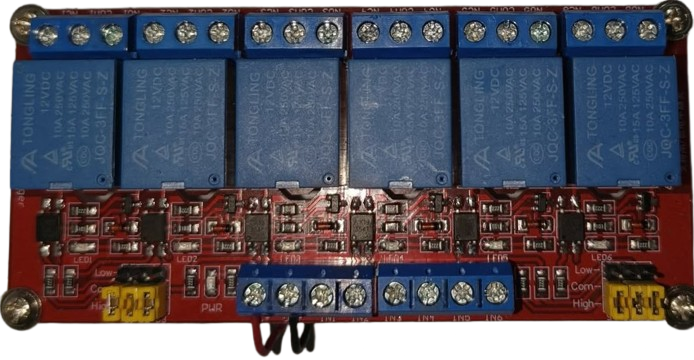
 Design with 6 Channel Relay in Cirkit Designer
Design with 6 Channel Relay in Cirkit DesignerIntroduction
The 6 Channel Relay (Manufacturer: Supes, Part ID: Relay) is an electromechanical switch designed to control up to six independent circuits using a single control signal. This versatile component is widely used in automation, home appliances, industrial control systems, and IoT projects. It allows low-power control signals, such as those from a microcontroller, to switch high-power devices like motors, lights, or other electrical loads.
Explore Projects Built with 6 Channel Relay
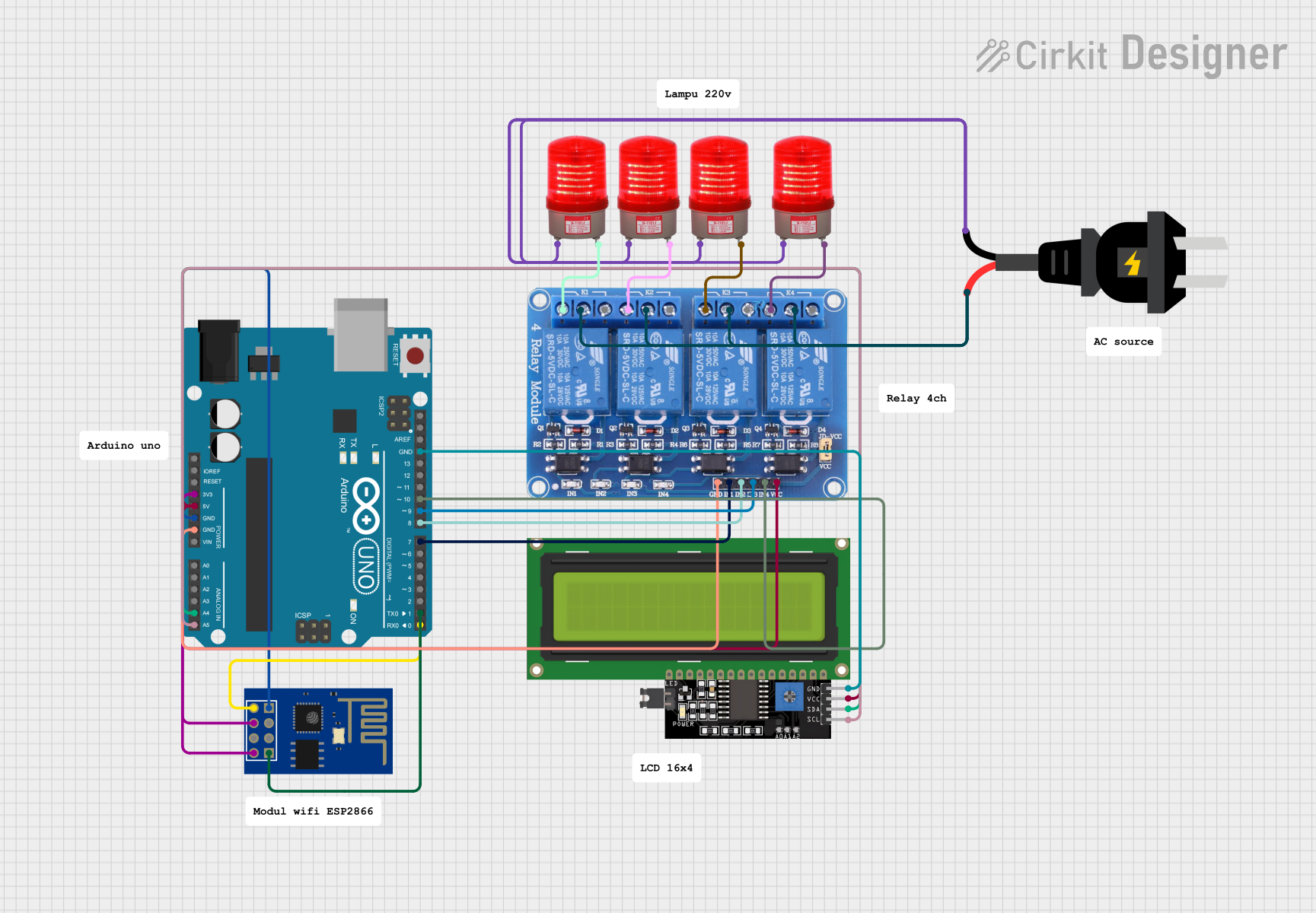
 Open Project in Cirkit Designer
Open Project in Cirkit Designer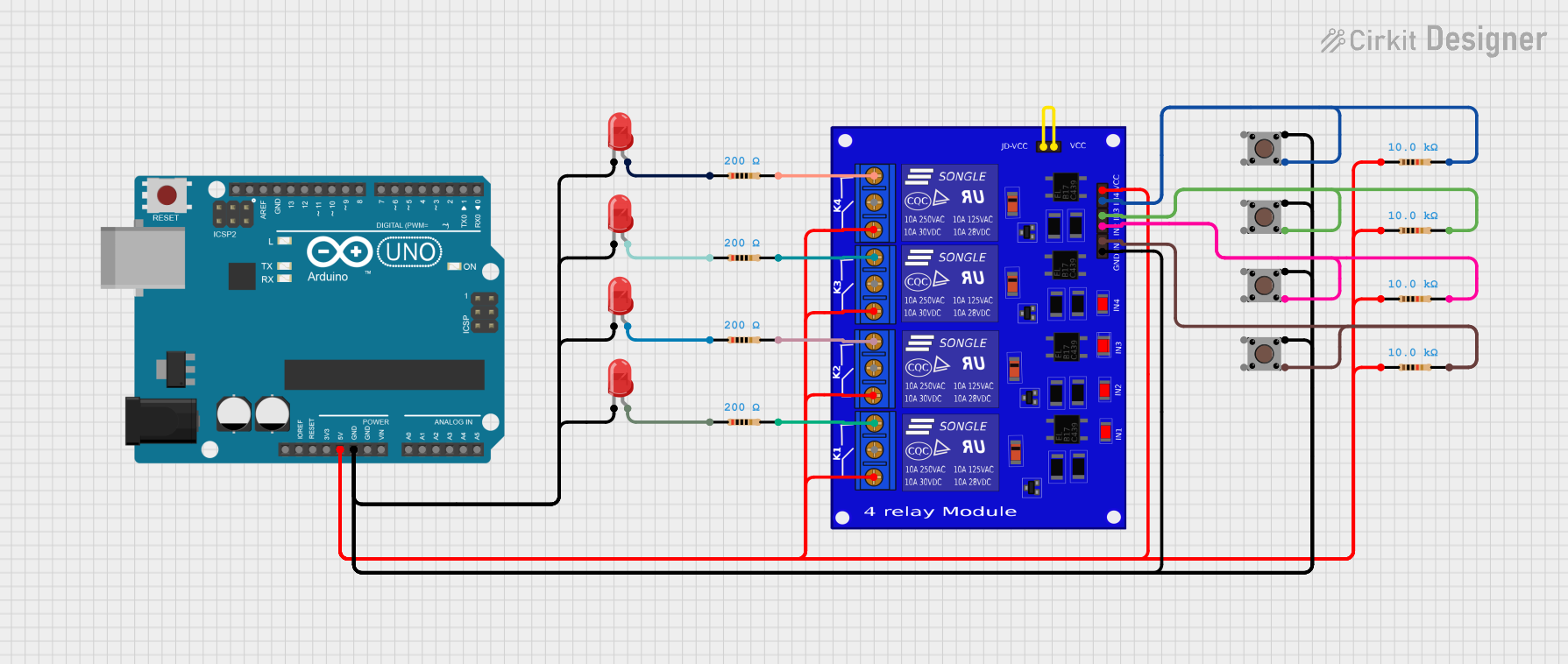
 Open Project in Cirkit Designer
Open Project in Cirkit Designer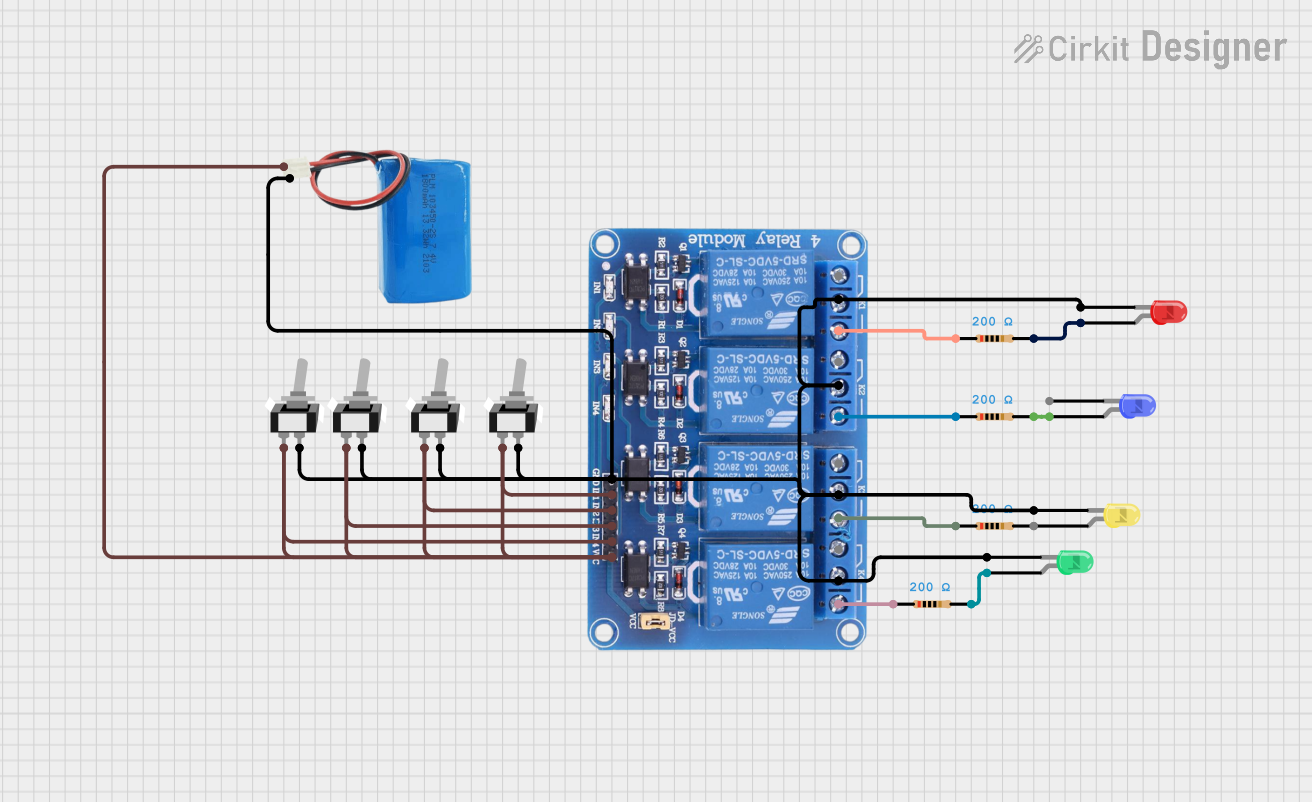
 Open Project in Cirkit Designer
Open Project in Cirkit Designer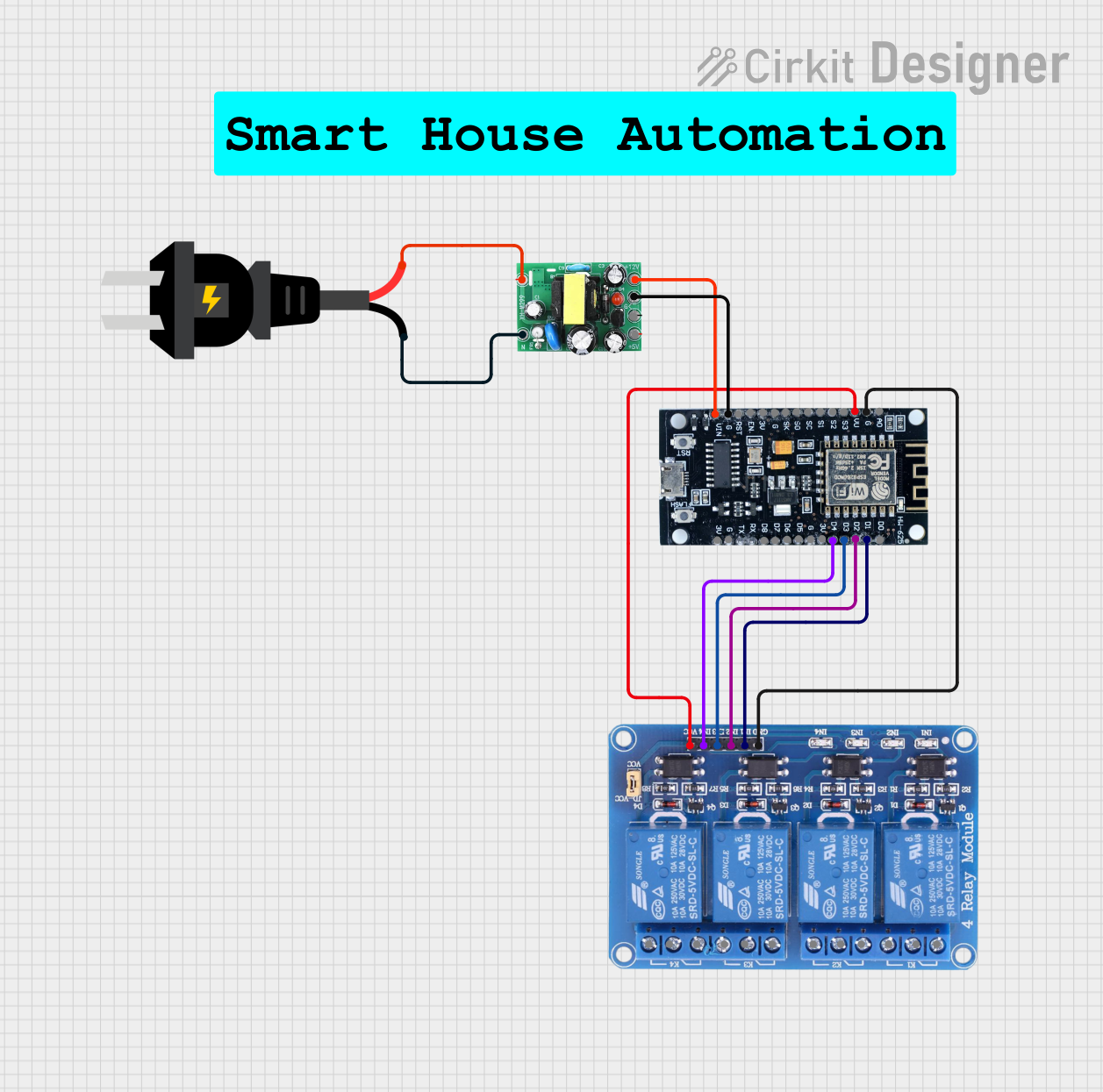
 Open Project in Cirkit Designer
Open Project in Cirkit DesignerExplore Projects Built with 6 Channel Relay

 Open Project in Cirkit Designer
Open Project in Cirkit Designer
 Open Project in Cirkit Designer
Open Project in Cirkit Designer
 Open Project in Cirkit Designer
Open Project in Cirkit Designer
 Open Project in Cirkit Designer
Open Project in Cirkit DesignerCommon Applications
- Home automation systems (e.g., controlling lights, fans, or appliances)
- Industrial equipment control
- Robotics and IoT projects
- Smart home devices
- Motor and pump control
Technical Specifications
The following table outlines the key technical details of the 6 Channel Relay:
| Parameter | Value |
|---|---|
| Operating Voltage | 5V DC |
| Trigger Voltage | 3.3V to 5V DC |
| Maximum Load Voltage | 250V AC / 30V DC |
| Maximum Load Current | 10A |
| Number of Channels | 6 |
| Relay Type | SPDT (Single Pole Double Throw) |
| Isolation | Optocoupler-based isolation |
| Dimensions | 140mm x 50mm x 20mm |
| Weight | ~120g |
Pin Configuration and Descriptions
The 6 Channel Relay module has the following pin configuration:
Control Pins
| Pin Name | Description |
|---|---|
| IN1 | Control signal for Relay 1 (Active LOW) |
| IN2 | Control signal for Relay 2 (Active LOW) |
| IN3 | Control signal for Relay 3 (Active LOW) |
| IN4 | Control signal for Relay 4 (Active LOW) |
| IN5 | Control signal for Relay 5 (Active LOW) |
| IN6 | Control signal for Relay 6 (Active LOW) |
| GND | Ground connection |
| VCC | Power supply input (5V DC) |
Relay Output Terminals
Each relay has three output terminals:
| Terminal Name | Description |
|---|---|
| NO (Normally Open) | Open circuit when relay is inactive |
| NC (Normally Closed) | Closed circuit when relay is inactive |
| COM (Common) | Common terminal for NO and NC |
Usage Instructions
How to Use the 6 Channel Relay in a Circuit
- Power the Module: Connect the VCC pin to a 5V DC power source and the GND pin to ground.
- Connect Control Signals: Use a microcontroller (e.g., Arduino UNO) to send control signals to the IN1–IN6 pins. A LOW signal activates the corresponding relay.
- Connect the Load: Attach the load (e.g., light, motor) to the relay's output terminals (COM, NO, NC) based on your switching requirements:
- Use COM and NO for devices that should be OFF by default and turn ON when the relay is activated.
- Use COM and NC for devices that should be ON by default and turn OFF when the relay is activated.
- Test the Circuit: Verify the connections and test the relay by toggling the control signals.
Important Considerations
- Ensure the load voltage and current do not exceed the relay's maximum ratings (250V AC / 30V DC, 10A).
- Use proper insulation and safety precautions when working with high-voltage loads.
- Avoid switching inductive loads (e.g., motors) without a flyback diode to prevent voltage spikes.
- Use optocoupler isolation to protect the microcontroller from high-voltage transients.
Example: Connecting to an Arduino UNO
Below is an example of how to control the 6 Channel Relay using an Arduino UNO:
Circuit Connections
- Connect the relay module's VCC to the Arduino's 5V pin.
- Connect the relay module's GND to the Arduino's GND pin.
- Connect the relay module's IN1–IN6 pins to Arduino digital pins (e.g., D2–D7).
Arduino Code
// Example code to control a 6 Channel Relay with Arduino UNO
// IN1–IN6 are connected to Arduino pins D2–D7 respectively
// Define relay control pins
#define RELAY1 2
#define RELAY2 3
#define RELAY3 4
#define RELAY4 5
#define RELAY5 6
#define RELAY6 7
void setup() {
// Set relay pins as OUTPUT
pinMode(RELAY1, OUTPUT);
pinMode(RELAY2, OUTPUT);
pinMode(RELAY3, OUTPUT);
pinMode(RELAY4, OUTPUT);
pinMode(RELAY5, OUTPUT);
pinMode(RELAY6, OUTPUT);
// Initialize all relays to OFF (HIGH state)
digitalWrite(RELAY1, HIGH);
digitalWrite(RELAY2, HIGH);
digitalWrite(RELAY3, HIGH);
digitalWrite(RELAY4, HIGH);
digitalWrite(RELAY5, HIGH);
digitalWrite(RELAY6, HIGH);
}
void loop() {
// Example: Turn relays ON and OFF sequentially
digitalWrite(RELAY1, LOW); // Turn ON Relay 1
delay(1000); // Wait 1 second
digitalWrite(RELAY1, HIGH); // Turn OFF Relay 1
digitalWrite(RELAY2, LOW); // Turn ON Relay 2
delay(1000); // Wait 1 second
digitalWrite(RELAY2, HIGH); // Turn OFF Relay 2
// Repeat for other relays...
}
Troubleshooting and FAQs
Common Issues and Solutions
Relays Not Activating
- Cause: Insufficient power supply.
- Solution: Ensure the module is powered with a stable 5V DC source.
Microcontroller Resetting
- Cause: Voltage spikes from inductive loads.
- Solution: Add flyback diodes across the load terminals to suppress voltage spikes.
Relay Stuck in ON/OFF State
- Cause: Faulty relay or incorrect wiring.
- Solution: Check the wiring and replace the relay if necessary.
Load Not Switching Properly
- Cause: Exceeding the relay's voltage/current ratings.
- Solution: Verify that the load's voltage and current are within the relay's specifications.
FAQs
Q1: Can I use the 6 Channel Relay with a 3.3V microcontroller?
A1: Yes, the relay module supports trigger voltages as low as 3.3V. However, ensure the module's VCC is powered with 5V.
Q2: Can I control AC and DC loads simultaneously?
A2: Yes, as long as the loads are connected to separate relays and do not exceed the module's ratings.
Q3: Is optocoupler isolation necessary?
A3: While the module includes optocoupler isolation, additional isolation may be required for high-voltage or sensitive applications.
Q4: Can I use fewer than six relays?
A4: Yes, you can use any number of relays by leaving unused control pins unconnected.